小学六年级英语下册全册教案设计(最新湘教版)
- 格式:doc
- 大小:278.50 KB
- 文档页数:58
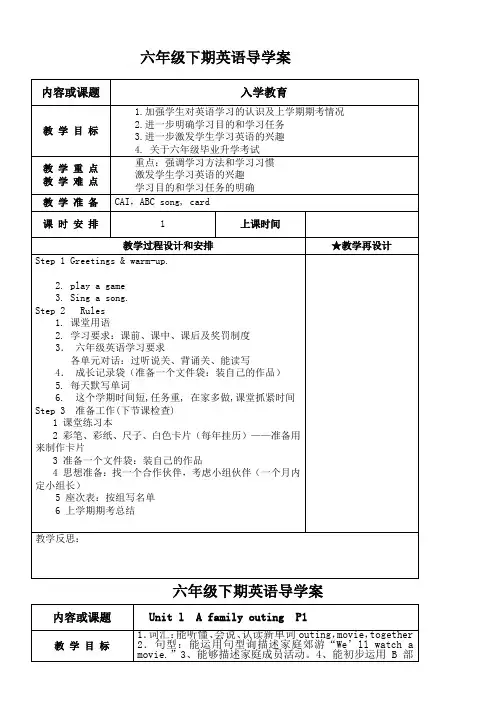
六年级下期英语导学案
六年级下期英语导学案
六年级下期英语导学案
六年级下期英语导学案
六年级下期英语导学案
六年级下期英语导学案
六年级下期英语导学案
六年级下期英语导学案
六年级下期英语导学案
六年级下期英语导学案
六年级下期英语导学案
六年级下期英语导学案
六年级下期英语导学案
六年级下期英语导学案
六年级下期英语导学案
六年级下期英语导学案
六年级下期英语导学案
六年级下期英语导学案
六年级下期英语导学案
六年级下期英语导学案
六年级下期英语导学案
六年级下期英语导学案
六年级下期英语导学案
六年级下期英语导学案
六年级下期英语导学案
六年级下期英语导学案
六年级下期英语导学案
六年级下期英语导学案。
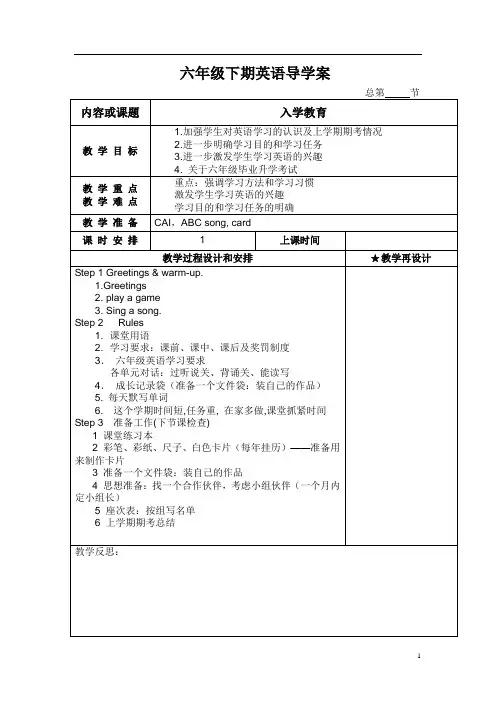
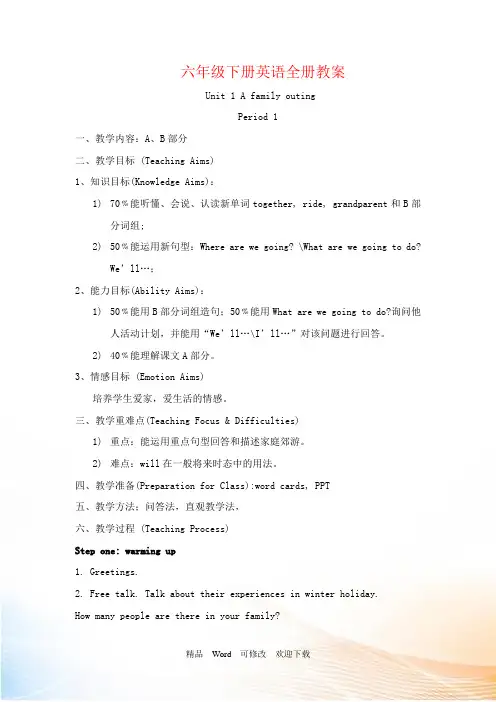
六年级下册英语全册教案Unit 1 A family outingPeriod 1一、教学内容:A、B部分二、教学目标 (Teaching Aims)1、知识目标(Knowledge Aims):1)70﹪能听懂、会说、认读新单词together, ride, grandparent和B部分词组;2)50﹪能运用新句型:Where are we going? \What are we going to do?We’ll…;2、能力目标(Ability Aims):1)50﹪能用B部分词组造句;50﹪能用What are we going to do?询问他人活动计划,并能用“We’ll…\I’ll…”对该问题进行回答。
2)40﹪能理解课文A部分。
3、情感目标 (Emotion Aims)培养学生爱家,爱生活的情感。
三、教学重难点(Teaching Focus & Difficulties)1)重点:能运用重点句型回答和描述家庭郊游。
2)难点:will在一般将来时态中的用法。
四、教学准备(Preparation for Class):word cards, PPT五、教学方法;问答法,直观教学法,六、教学过程 (Teaching Process)Step one: warming up1. Greetings.2. Free talk. Talk about their experiences in winter holiday.How many people are there in your family?What do you usually do at weekends with your family?Step two: presentationIntroduce new words and phrases.1、Listen to the tape of part B and repeat.2、运用“直观教学法”教授新单词,让学生学习、体验生活中的英语。

湘教版小学六年级英语下册教案Unit 1 You are good at drawing, Peter.Period 1Teaching aims:1.Ss can be confident in English studying.2.Enable the Ss to listen, read, say and write the new words: diving, pictures, good idea, watching films.3.Enable the Ss to be familiar with the sentence pattern: I like doing sth. I’m good at…Teaching emphasis:Enable the Ss to listen, read, say and write the new words.Teaching difficulties:Enable the Ss to be familiar with the sentence pattern: I like doing sth. I’m good at…Teaching tools:Tape, picturesTeaching methods:Task teaching method, Audio-linguistic method.Teaching steps:Step 1 Warming up1.Greetings.2.Make a conversation with the Ss.3.Play a game--- Doing and say.Eg: swimming, running…I like swimming. I’m good at swimming.Step 2 Presentation and drill1. Show the picture of “diving” .T: I like diving. I’m good at diving.The Ss read after the T: Diving, diving, diving.T: Can you spell the word “ diving”, please?T: I like drawing. I’m good at drawing.Show some pictures, and learn the word.2. Learn the other words in the similar way.3. Read together.4. Little teacher.Step 3 Practice1. T: I don’t like running. I like swimming. I’m good at swimming.S1: I don’t like swimming. I like skating. I’m good at skating.…2. The Ss act and say.3. Pair-work.4. Act it out.Step 4 Consolidation1.Evaluation.2.Do Ex.3.Homework. Copy the new words. Design of the blackboard:Unit 1 You are good at drawing, Peter. pictures good idea watch a filmI 'm not good at skating.I’m good at swimming.you are good at drawing, Peter.Unit 1 You are good at drawing, Peter.Period 2Teaching aims:1.Ss can get fun from English studying.2.Enable the Ss to listen, read and say the dialogue.3.Ena ble the Ss to master the sentence pattern: like doing sth, don’t like doing sth. Be good at doing…Teaching emphasis:Enable the Ss to listen, read and say the dialogue.Teaching difficulties:Enable the Ss to master the sentence pattern:like doing sth,don’t like doing sth.Be good at doing…Teaching tools:Tape, pictures, computer.Teaching methods:Task teaching method, Audio-linguistic method.Teaching steps:Step 1 Warming up1.Greetings.2.Act and say.T: I don’t like running. I like swimming. I’m good at swimming.S1: I don’t like swimming. I like skating. I’m good at skating.…Step 2 Presentation and drill1.Ask and answer:T: What do you like doing, Peter?Peter: I like reading. I don’t like singing.2. Listen to the tape and answer the questions.What is Anne like doing?What is Peter like doing?What is Lingling like doing?What is Mingming like doing?3. Explain the difficulties.Step 3 Practice1. Listen to the tape and repeat.2. Read after T.3. Read together.4. Pair-work.5. Little teacher.Step 4 Consolidation1.Evaluation.2.Do Ex.3.Homework.Design of the blackboard:Unit 1 You are good at drawing, Peter.What do you like doing, Peter?I like reading.I don’t like singing.I’m good at swimming.Period 3Teaching aims:1.Enable the to Ss talk about themselves happily.2.Enable the Ss to make sentences about themselves;3. Educate the Ss to finish the Ex.Teaching emphasis:Enable the Ss to talk about themselves.Teaching difficulties:Enable the Ss to finish the Ex.Teaching tools:Tape, computer.Teaching method:Task teaching method, Audio-linguistic method. Teaching steps:Step 1 Warming up1. Greetings.2. Read Part A together.Step 2 Presentation and drill1. T: Now please finish Part D: Talk about ourselves.2. Check the answer.3. Ask two Ss to retell the story.Step 3 Practice1. Class work. Look at the pictures, describe what each person is doing.2. What are they doing? Write sentences about 5 of the above pictures. Write the number of the picture in each box.3. Let’s sing.4. Let’s find out and write. The children are going to the cinema to watcha film. Draw lines to show how they go to the cinema. Write sentences to show how they go there.Step 4 Consolidation1.Do Ex. Workbook Unit 1.2.Evaluation.3.Homework. Revise Unit 1.Design of the blackboard:Unit 1 You are good at drawing, Peter.He is good at running.Jane is good at writing.Sally likes playing football.Period 4Teaching contents :Theme : You’re good at drawing ,Peter.Function: To know the grammar of how to use patterns :1)be good at …, 2) like doing…..Language : What are you good at?I am good at swimming.I am not good at singing.V ocabulary: diving, pictures, skating, good idea, watching films Teaching steps:1.Greetings :a)Good morning/afternoon boys and girls. How are you? Are you happy today ? What’s the weather like today? The Ss greet me at the same time . And answer my questions in correct way.b)Now ,who is on duty today ? The two students will give the class a duty talk that prepared by themselves .2.Warmer:1) Let’s to visit our old friends Lingling, Mingming, Peter and Anne. (CAI SHOWS )2) Review the verbs that we have learnt last term : run, eat, jump, swim, sit, draw, sing, etc.3.Presentation : Activity 1.Part B --let’s learn .1)Play the cassette of the words in Part B . The children listen.2)Play the CAI and ask the Ss to read the words after it several times. Then pause after each word for the Ss , then they read after it.3)Recite: This time ask Ss to recite the words as much as they can . And only give them 2 minutes . Then ask some of them to recite the words and as much as they can. If they also can act the words ,I will give thema praise.4)CAI shows some present participle words ,and ask the pupils to compare them with common verbs .Run Swim Jump sing drawRunning Swimming Jumping singing drawing5)Then lead in the grammar :I like doing sth. out. And give them some examples. Ex: I like swimming.Activity 2.Part A --- Let’s listen and say .Play the cassette and ask the Ss to listen the dialogue twice. Then ask them to answer the questions about the dialogue. It means to understand the dialogue quite well. The questions are:How many persons are there in this dialogue?What was Mingming not good at?Who was good at diving?What did Peter like doing? Etc.Then play the cassette again and ask them to listen once more.3)Explain the sentences if it is necessary .4)Then ask the Ss to read the story several times till fluently .5)Then CAI shows the questions again and ask the Ss to write the answers of questions on the notebook.6)Let the Ss to read their answers and then check the answers together.7)Ask several students to act the story out.Activity 3.Part C ---About the story.1) Ask the pupils to open their books and finish the questions in pairs.4.Homework : 1)Ask them to write 6 times for each word in the exercise book.2)Listen to tape several times at home and finish the exercise of Part F。
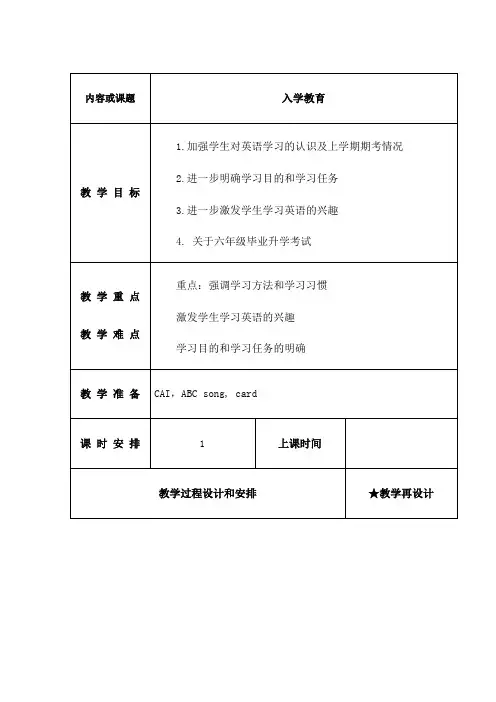

新版湘少版小学六年级英语下册全册教案(word版可编辑修改)编辑整理:尊敬的读者朋友们:这里是精品文档编辑中心,本文档内容是由我和我的同事精心编辑整理后发布的,发布之前我们对文中内容进行仔细校对,但是难免会有疏漏的地方,但是任然希望(新版湘少版小学六年级英语下册全册教案(word版可编辑修改))的内容能够给您的工作和学习带来便利。
同时也真诚的希望收到您的建议和反馈,这将是我们进步的源泉,前进的动力。
本文可编辑可修改,如果觉得对您有帮助请收藏以便随时查阅,最后祝您生活愉快业绩进步,以下为新版湘少版小学六年级英语下册全册教案(word版可编辑修改)的全部内容。
Unit 1 A family outingPeriod 1一、教学目标 (Teaching Aims)1、知识目标(Knowledge Aims):1)能看懂、会读、会说新单词together, ride, grandparents;2)学习、运用新句型:Shall we… We’ll…2、能力目标(Ability Aims):1)能向他人询问、回答出行计划;2)能理解课本A与B部分。
3、情感目标(Emotion Aims)学会小组合作,团结友爱。
二、教学重难点(Teaching Focus & Difficulties)1)重点:理解并运用生单词;2)难点:运用新句型.1)课前准备(Preparation for Class)课件、图片、卡片、教学录音等等。
2)教学过程 (Teaching Process)Step one: warming up1。
Greetings。
2. Free talk. Talk about their experiences in winter holiday.Step two: presentationIntroduce new words and phrases.T: Do you want to do these things? Watch a movie? Go shopping? Take/ have a walk? Look at the flowers? I think, it is happy for us to do things together。

新版湘少版六年级英语下册全册教案
集团档案编码:[YTTR-YTPT28-YTNTL98-UYTYNN08]
六年级下期英语导学案
六年级下期英语导学案
六年级下期英语导学案
六年级下期英语导学案
六年级下期英语导学案
六年级下期英语导学案
六年级下期英语导学案
六年级下期英语导学案
六年级下期英语导学案
六年级下期英语导学案
六年级下期英语导学案
六年级下期英语导学案
六年级下期英语导学案
六年级下期英语导学案
六年级下期英语导学案
六年级下期英语导学案
六年级下期英语导学案
六年级下期英语导学案
六年级下期英语导学案
六年级下期英语导学案
六年级下期英语导学案
六年级下期英语导学案
六年级下期英语导学案
六年级下期英语导学案
六年级下期英语导学案
六年级下期英语导学案
六年级下期英语导学案
六年级下期英语导学案。
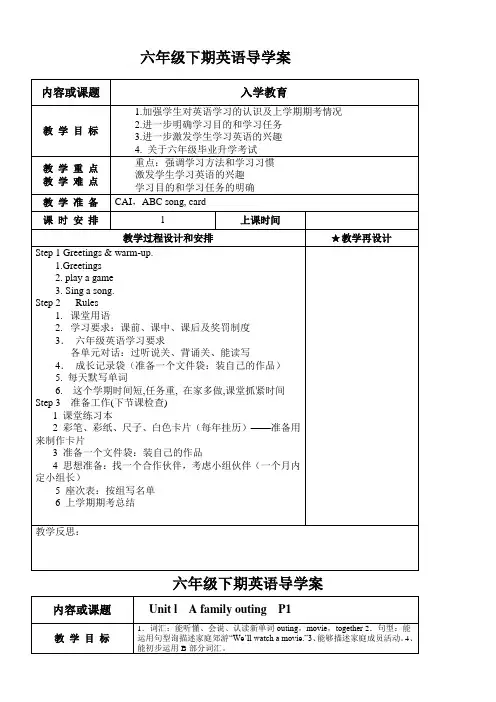
六年级下期英语导学案
六年级下期英语导学案
六年级下期英语导学案
六年级下期英语导学案
六年级下期英语导学案
六年级下期英语导学案
六年级下期英语导学案
六年级下期英语导学案
六年级下期英语导学案
六年级下期英语导学案
六年级下期英语导学案
六年级下期英语导学案
六年级下期英语导学案
六年级下期英语导学案
六年级下期英语导学案
六年级下期英语导学案
六年级下期英语导学案
六年级下期英语导学案
六年级下期英语导学案
六年级下期英语导学案
六年级下期英语导学案
六年级下期英语导学案
六年级下期英语导学案
六年级下期英语导学案
六年级下期英语导学案
六年级下期英语导学案
六年级下期英语导学案
六年级下期英语导学案。
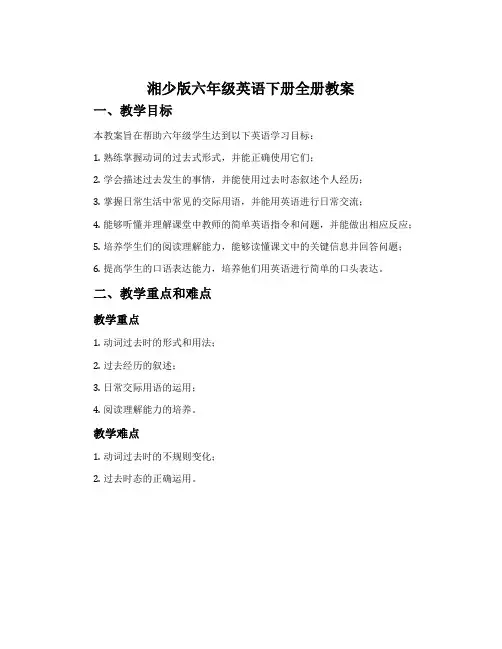
湘少版六年级英语下册全册教案一、教学目标本教案旨在帮助六年级学生达到以下英语学习目标:1.熟练掌握动词的过去式形式,并能正确使用它们;2.学会描述过去发生的事情,并能使用过去时态叙述个人经历;3.掌握日常生活中常见的交际用语,并能用英语进行日常交流;4.能够听懂并理解课堂中教师的简单英语指令和问题,并能做出相应反应;5.培养学生们的阅读理解能力,能够读懂课文中的关键信息并回答问题;6.提高学生的口语表达能力,培养他们用英语进行简单的口头表达。
二、教学重点和难点教学重点1.动词过去时的形式和用法;2.过去经历的叙述;3.日常交际用语的运用;4.阅读理解能力的培养。
教学难点1.动词过去时的不规则变化;2.过去时态的正确运用。
三、教学内容与教学步骤Unit 1: My school day1. 教学内容本单元主要围绕描述学生在学校的一天所做的事情展开。
学生将学会使用动词的过去时来描述过去发生的事情,并能使用一般疑问句和回答句进行简单的交流。
2. 教学步骤•Step 1: Pre-reading–创设情境,引入新课,向学生展示与课文相关的图片,激发他们的学习兴趣;–跟学生一起讨论图片内容,引导他们对即将学习的课文内容进行猜测。
•Step 2: While-reading–学生个别展示自己一天的学校生活,并使用过去时句型进行描述;–教师向学生介绍新的词汇和句型,通过示范教学巧妙导入课文让学生更好地理解课文;–学生自主阅读课文,尝试回答课文中的问题,并扩展他们的回答;–小组合作活动:学生分组进行角色扮演,练习使用课文中的句型进行交际。
•Step 3: Post-reading–学生合作讨论并互相校对他们在小组活动中的对话内容;–最后,教师提供反馈和指导,帮助学生纠正错误,并加强对课文内容的理解。
Unit 2: My vacation1. 教学内容本单元主要围绕学生的假期活动展开。
学生将学会使用过去时描述自己在假期里的所见所闻,并能使用简单的句式描述自己的兴趣、喜好等。

六年级下期英语导学案
六年级下期英语导学案
六年级下期英语导学案
六年级下期英语导学案
六年级下期英语导学案
六年级下期英语导学案
六年级下期英语导学案
六年级下期英语导学案
六年级下期英语导学案
六年级下期英语导学案
六年级下期英语导学案
六年级下期英语导学案
六年级下期英语导学案
六年级下期英语导学案
六年级下期英语导学案
六年级下期英语导学案
六年级下期英语导学案
六年级下期英语导学案
六年级下期英语导学案
六年级下期英语导学案
六年级下期英语导学案
六年级下期英语导学案
六年级下期英语导学案
六年级下期英语导学案
六年级下期英语导学案
六年级下期英语导学案
六年级下期英语导学案
六年级下期英语导学案。
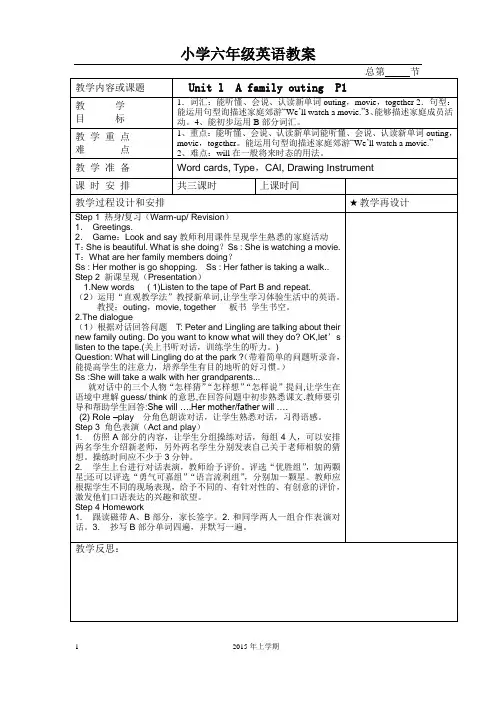
六年级下期英语导学案
六年级下期英语导学案
六年级下期英语导学案
六年级下期英语导学案
六年级下期英语导学案
六年级下期英语导学案
六年级下期英语导学案
六年级下期英语导学案
六年级下期英语导学案
六年级下期英语导学案
六年级下期英语导学案
六年级下期英语导学案
六年级下期英语导学案
六年级下期英语导学案
六年级下期英语导学案
六年级下期英语导学案
六年级下期英语导学案
六年级下期英语导学案
六年级下期英语导学案
六年级下期英语导学案
六年级下期英语导学案
六年级下期英语导学案
六年级下期英语导学案
六年级下期英语导学案
六年级下期英语导学案
六年级下期英语导学案。
新版湘少版六年级英语下
册全册教案
It was last revised on January 2, 2021
六年级下期英语导学案
六年级下期英语导学案
六年级下期英语导学案
六年级下期英语导学案
六年级下期英语导学案
六年级下期英语导学案
六年级下期英语导学案
六年级下期英语导学案
六年级下期英语导学案
六年级下期英语导学案
六年级下期英语导学案
六年级下期英语导学案
六年级下期英语导学案
六年级下期英语导学案
六年级下期英语导学案
六年级下期英语导学案
六年级下期英语导学案
六年级下期英语导学案
六年级下期英语导学案
六年级下期英语导学案
六年级下期英语导学案
六年级下期英语导学案
六年级下期英语导学案
六年级下期英语导学案
六年级下期英语导学案
六年级下期英语导学案
六年级下期英语导学案
六年级下期英语导学案。
六年级下期英语导学案
六年级下期英语导学案
六年级下期英语导学案
六年级下期英语导学案
六年级下期英语导学案
六年级下期英语导学案
六年级下期英语导学案
六年级下期英语导学案
六年级下期英语导学案
六年级下期英语导学案
六年级下期英语导学案
六年级下期英语导学案
六年级下期英语导学案
六年级下期英语导学案
六年级下期英语导学案
六年级下期英语导学案
六年级下期英语导学案
六年级下期英语导学案
六年级下期英语导学案
六年级下期英语导学案
六年级下期英语导学案
六年级下期英语导学案
六年级下期英语导学案
六年级下期英语导学案
六年级下期英语导学案
六年级下期英语导学案。
湘教版小学六年级英语下册教案Unit 1 You are good at drawing, Peter.Period 1Teaching aims:1.Ss can be confident in English studying.2.Enable the Ss to listen, read, say and write the new words: diving, pictures, good idea, watching films.3.Enable the Ss to be familiar with the sentence pattern: I like doing sth. I’m good at…Teaching emphasis:Enable the Ss to listen, read, say and write the new words.Teaching difficulties:Enable the Ss to be familiar with the sentence pattern: I like doing sth. I’m good at…Teaching tools:Tape, picturesTeaching methods:Task teaching method, Audio-linguistic method.Teaching steps:Step 1 Warming up1.Greetings.2.Make a conversation with the Ss.3.Play a game--- Doing and say.Eg: swimming, running…I like swimming. I’m good at swimming.Step 2 Presentation and drill1. Show the picture of “diving” .T: I like diving. I’m good at diving.The Ss read after the T: Diving, diving, diving.T: Can you spell the word “ diving”, please?T: I like drawing. I’m good at drawing.Show some pictures, and learn the word.2. Learn the other words in the similar way.3. Read together.4. Little teacher.Step 3 Practice1. T: I don’t like running. I like swimming. I’m good at swimming.S1: I don’t like swimming. I like skating. I’m good at skating.…2. The Ss act and say.3. Pair-work.4. Act it out.Step 4 Consolidation1.Evaluation.2.Do Ex.3.Homework. Copy the new words. Design of the blackboard:Unit 1 You are good at drawing, Peter. pictures good idea watch a filmI 'm not good at skating.I’m good at swimming.you are good at drawing, Peter.Unit 1 You are good at drawing, Peter.Period 2Teaching aims:1.Ss can get fun from English studying.2.Enable the Ss to listen, read and say the dialogue.3.Ena ble the Ss to master the sentence pattern: like doing sth, don’t like doing sth. Be good at doing…Teaching emphasis:Enable the Ss to listen, read and say the dialogue.Teaching difficulties:Enable the Ss to master the sentence pattern:like doing sth,don’t like doing sth.Be good at doing…Teaching tools:Tape, pictures, computer.Teaching methods:Task teaching method, Audio-linguistic method.Teaching steps:Step 1 Warming up1.Greetings.2.Act and say.T: I don’t like running. I like swimming. I’m good at swimming.S1: I don’t like swimming. I like skating. I’m good at skating.…Step 2 Presentation and drill1.Ask and answer:T: What do you like doing, Peter?Peter: I like reading. I don’t like singing.2. Listen to the tape and answer the questions.What is Anne like doing?What is Peter like doing?What is Lingling like doing?What is Mingming like doing?3. Explain the difficulties.Step 3 Practice1. Listen to the tape and repeat.2. Read after T.3. Read together.4. Pair-work.5. Little teacher.Step 4 Consolidation1.Evaluation.2.Do Ex.3.Homework.Design of the blackboard:Unit 1 You are good at drawing, Peter.What do you like doing, Peter?I like reading.I don’t like singing.I’m good at swimming.Period 3Teaching aims:1.Enable the to Ss talk about themselves happily.2.Enable the Ss to make sentences about themselves;3. Educate the Ss to finish the Ex.Teaching emphasis:Enable the Ss to talk about themselves.Teaching difficulties:Enable the Ss to finish the Ex.Teaching tools:Tape, computer.Teaching method:Task teaching method, Audio-linguistic method. Teaching steps:Step 1 Warming up1. Greetings.2. Read Part A together.Step 2 Presentation and drill1. T: Now please finish Part D: Talk about ourselves.2. Check the answer.3. Ask two Ss to retell the story.Step 3 Practice1. Class work. Look at the pictures, describe what each person is doing.2. What are they doing? Write sentences about 5 of the above pictures. Write the number of the picture in each box.3. Let’s sing.4. Let’s find out and write. The children are going to the cinema to watcha film. Draw lines to show how they go to the cinema. Write sentences to show how they go there.Step 4 Consolidation1.Do Ex. Workbook Unit 1.2.Evaluation.3.Homework. Revise Unit 1.Design of the blackboard:Unit 1 You are good at drawing, Peter.He is good at running.Jane is good at writing.Sally likes playing football.Period 4Teaching contents :Theme : You’re good at drawing ,Peter.Function: To know the grammar of how to use patterns :1)be good at …, 2) like doing…..Language : What are you good at?I am good at swimming.I am not good at singing.V ocabulary: diving, pictures, skating, good idea, watching films Teaching steps:1.Greetings :a)Good morning/afternoon boys and girls. How are you? Are you happy today ? What’s the weather like today? The Ss greet me at the same time . And answer my questions in correct way.b)Now ,who is on duty today ? The two students will give the class a duty talk that prepared by themselves .2.Warmer:1) Let’s to visit our old friends Lingling, Mingming, Peter and Anne. (CAI SHOWS )2) Review the verbs that we have learnt last term : run, eat, jump, swim, sit, draw, sing, etc.3.Presentation : Activity 1.Part B --let’s learn .1)Play the cassette of the words in Part B . The children listen.2)Play the CAI and ask the Ss to read the words after it several times. Then pause after each word for the Ss , then they read after it.3)Recite: This time ask Ss to recite the words as much as they can . And only give them 2 minutes . Then ask some of them to recite the words and as much as they can. If they also can act the words ,I will give thema praise.4)CAI shows some present participle words ,and ask the pupils to compare them with common verbs .Run Swim Jump sing drawRunning Swimming Jumping singing drawing5)Then lead in the grammar :I like doing sth. out. And give them some examples. Ex: I like swimming.Activity 2.Part A --- Let’s listen and say .Play the cassette and ask the Ss to listen the dialogue twice. Then ask them to answer the questions about the dialogue. It means to understand the dialogue quite well. The questions are:How many persons are there in this dialogue?What was Mingming not good at?Who was good at diving?What did Peter like doing? Etc.Then play the cassette again and ask them to listen once more.3)Explain the sentences if it is necessary .4)Then ask the Ss to read the story several times till fluently .5)Then CAI shows the questions again and ask the Ss to write the answers of questions on the notebook.6)Let the Ss to read their answers and then check the answers together.7)Ask several students to act the story out.Activity 3.Part C ---About the story.1) Ask the pupils to open their books and finish the questions in pairs.4.Homework : 1)Ask them to write 6 times for each word in the exercise book.2)Listen to tape several times at home and finish the exercise of Part F。